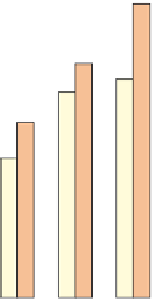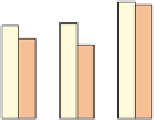Geoscience Reference
In-Depth Information
5
1974-1995
2001-2100
4
3
2
1
0
Jan
Feb
Mar
Apr
May
Jun
Jul
Aug
Sep
Oct
Nov
Dec
Month
Figure 4.2
Current and projected discharge of the river Lambourn, southern England.
(Littlewood 2002), the mean monthly discharge for 2071-2100 was predicted.
The current and modelled discharge time series were compared for magnitude,
frequency and timing of extreme discharge events.
A more variable discharge regime for the river Lambourn by the end of this
century is predicted. The biggest difference between now and then is the size of
the winter peaks. During 1974-95, 45% of annual peaks exceeded 3 m
3
s
−1
, while
for 2071-2100, 83% of peaks are predicted to exceed this level. There were two
prolonged drought events in 1974-95, caused by a lack of sufficient winter
recharge in 1976 and again in 1991 and 1992. The modelled discharge data for
2071-2100 predict that equivalent winter droughts are less likely to occur. Even
the poorest winter recharge levels for the projected period are comparable with
current normal recharge levels. The median and range of summer and autumn
low flows are not predicted to change to such a severe extent as in winter and
spring. However, midsummer discharges may generally be slightly increased and
the winter recharge may be delayed by about 1 month, shifting from November
to December. These predicted changes to discharge magnitude, frequency and
timing are likely to affect the physical structure of the River Lambourn and its
riparian zone, as well as the flora and fauna it supports.
Climate change will thus alter the dominant pattern of precipitation, which in
turn changes run-off and discharge regimes, including spates and droughts in
streams and rivers. Spates and droughts are important drivers that contribute to
stream patchiness. Climate change, therefore, presents a challenge to the structure
and function of current stream ecosystems (Meyer
et al
. 1999; Wright
et al
. 2004).
During spates, habitats may be destroyed; during low flows, they will be silted,
and during base-flow conditions, habitats will be generated again (Lake 2000).



























































































Search WWH ::

Custom Search